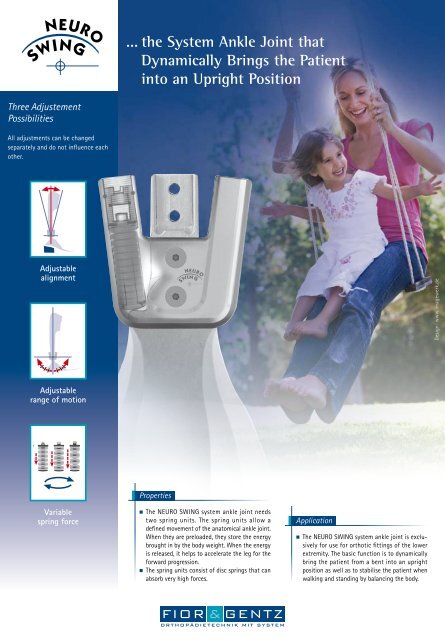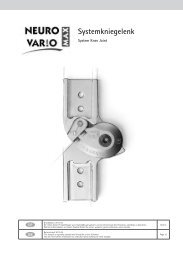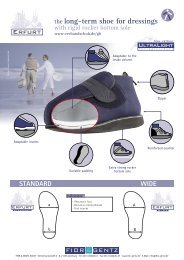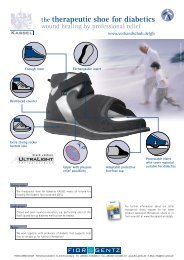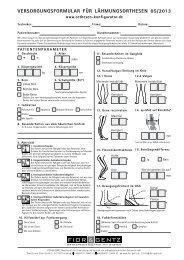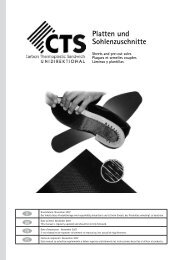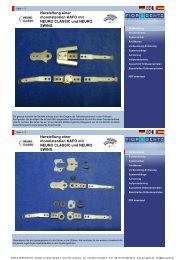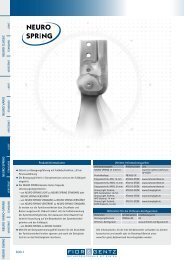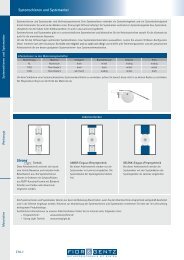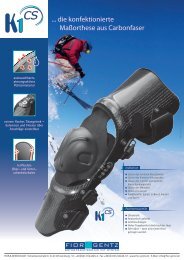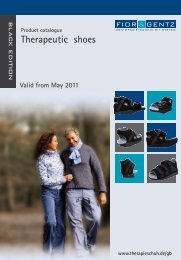Leaflet - Fior & Gentz
Leaflet - Fior & Gentz
Leaflet - Fior & Gentz
- No tags were found...
You also want an ePaper? Increase the reach of your titles
YUMPU automatically turns print PDFs into web optimized ePapers that Google loves.
... the System Ankle Joint thatDynamically Brings the Patientinto an Upright PositionThree AdjustementPossibilitiesAll adjustments can be changedseparately and do not influence eachother.AdjustablealignmentDesign: www.imagewerk.deAdjustablerange of motionVariablespring forceProperties• The NEURO SWING system ankle joint needstwo spring units. The spring units allow adefined movement of the anatomical ankle joint.When they are preloaded, they store the energybrought in by the body weight. When the energyis released, it helps to accelerate the leg for theforward progression.• The spring units consist of disc springs that canabsorb very high forces.Application• The NEURO SWING system ankle joint is exclusivelyfor use for orthotic fittings of the lowerextremity. The basic function is to dynamicallybring the patient from a bent into an uprightposition as well as to stabilise the patient whenwalking and standing by balancing the body.
Properties of theNEURO SWINGDisadvantagesof existing AFOsDescriptionThe lever effect of an orthosis can be exactly adjusted to the pathological gaitdue to mounting the NEURO SWING system ankle joint. In case of changesin the pathological gait, the orthosis can be easily and effectively readjusted.An alignment of almost each orthosis is absolutely necessary but is difficultor not at all possible when using common products without any mechanicalorthotic joint.Adjustable alignmentNot adjustable alignmentDefined pivot pointNo defined pivot pointMounting the NEURO SWING system ankle joint, it supports the range ofmotion of the upper ankle joint, since the mechanical pivot point lies exactlyon the anatomical pivot point of the ankle joint. This defined pivot point supportsa qualified physiotherapy to treat insufficient muscles by making the rightcerebral connections due to motor impulses as well as strengthening singlemuscle groups due to specific muscle training. Even without a mechanical anklejoint some orthoses sometimes allow movement between foot and lower leg.But these orthoses only allow insufficient movement in the anatomical anklejoint during gait cycle what can result in muscular atrophies. Since the pivotpoint is not defined, the shells of the orthosis can be shifted on the leg whatcan cause skin irritations.Plantar flexion possiblePlantar flexion lockedA physiological plantar flexion is enabled due to adjustable spring force andrange of motion in plantar flexion. A qualified physiotherapy uses this to treatinsufficient muscles. The right cerebral connections are made due to motorimpulses as well as single muscle groups are strengthened due to specificmuscle training. Thus, muscular atrophy cannot be increased. Limiting thephysiological plantar flexion leads to an excessive heel rocker function. Therefore,a too strong torque on the lower leg is transmitted to the knee. This leads toan increased demand on the m. quadriceps (e.g. going downhill with a ski boot)although patients with disorders of the central nervous system mostly have atoo weak m. quadriceps.During treatment it can be required to limit the range of motion of an orthosisor to completely lock it and later allow it again. Thus, an ankle joint withindividually adjustable range of motion must be mounted into the orthosis.Adjustable range of motionDisc springHigh spring forceExchangeable spring unitsNot adjustable range of motionElastomer spring joint Coil spring jointLow spring forcePatients with a disorder of the central nervous system need an ankle jointwith extreme high spring forces in plantar flexion as well as in dorsiflexion.Only this way the patient can come closer to the physiological gait, stabilisewhen walking and standing and balance his body. For this purpose, posteriorleaf spring orthoses have been used until now. These needed spring forces areobtained by the NEURO SWING system ankle joint where the disc springs arestacked to compact spring units. The spring units are preloaded and store theenergy brought in by the body weight. Common constructions such as elastomerspring or coil spring joints nearly cannot achieve this effect.Patients with a disorder of the central nervous system need a spring force thatis adjustable to the patient's pathological gait during treatment. The springforce in plantar flexion and dorsiflexion can be adjusted individually withoutgreat effort by using spring units of different strength. In orthoses withoutankle joint, it is not easy or not possible to change the spring force.Variable spring forceNo variable spring forceThe integrated disc springs enable a soft stop that counteracts the developmentor impairment of spasticities. At the same time, it has a positive effecton the sense of balance what results in stabilising the patient when walkingand standing.Soft stopsHard stops


